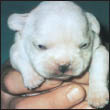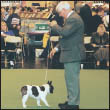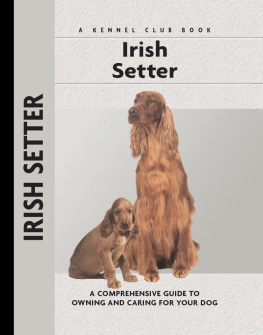
Physical Characteristics of the French Bulldog
(from the American Kennel Club breed standard)
Head: Large and square.
Skull: Top of the skull flat between the ears; the forehead is not flat but slightly rounded.
Eyes: Dark in color, wide apart, set low down in the skull, as far from the ears as possible, round in form, of moderate size, neither sunken nor bulging.
Nose: Black.
Muzzle: Broad, deep and well laid back; the muscles of the cheeks well developed. The stop well defined, causing a hollow groove between the eyes with heavy wrinkles forming a soft roll over the extremely short nose; nostrils broad with a well defined line between them.
Flews: Black, thick and broad, hanging over the lower jaw at the sides, meeting the underlip in front and covering the teeth, which are not seen when the mouth is closed. The underjaw is deep, square, broad, undershot and well turned up.
Ears: Known as the bat ear, broad at the base, elongated, with round top, set high on the head but not too close together, and carried erect with the orifice to the front. The leather of the ear fine and soft.
Neck: Thick and well arched with loose skin at the throat.
Back: Roach back with a slight fall close behind the shoulders; strong and short, broad at the shoulders and narrowing at the loins.
Forequarters: Forelegs are short, stout, straight, muscular and set wide apart. Dewclaws may be removed.

Body: Short and well rounded. The chest is broad, deep and full; well ribbed with the belly tucked up.
Tail: Either straight or screwed (but not curly), short, hung w, thick root and fine tip; carried low in repose.
Hindquarters: Hind legs are strong and muscular, longer than the forelegs, so as to elevate the loins above the shoulders. Hocks well let down.
Coat: Moderately fine, brilliant, short and smooth. Skin is soft and loose, especially at the head and shoulders, forming wrinkles.
Color: Acceptable colorsAll brindle, fawn, white, brindle and white, and any color except those which constitute disqualification. All colors are acceptable with the exception of solid black, mouse, liver, black and tan, black and white, and white with black, which are disqualifications. Black means black without a trace of brindle.
Feet: Moderate in size, compact and firmly set. Toes compact, well split up, with high knuckles and short stubby nails.
Weight: Not to exceed 28 pounds.
Contents

Trace the beginnings of le Bouledogue Franaisfrom its bull-baiting uncles to its Toy Bulldog cousins to its French and American brethrento see how the breed became the recognizably handsome pure-bred it is today. Meet the foundation breeders and their award-winning dogs to see how the bat-eared French Bulldog came to be.

Cozy up to the irresistible Frenchie, one of the worlds companion dogs par excellence, known for his clown-like propensities and his adorable antics. Discover whether this low-maintenance home companion is the right dog for you and your family, and be aware of the breeds expectations, limitations and health concerns.

Learn the requirements of a well-bred French Bulldog by studying the description of the breed set forth in the American Kennel Club standard. Both show dogs and pets must possess key characteristics as outlined in the breed standard.

Find out about how to locate a well-bred French Bulldog puppy. Discover which questions to ask the breeder and what to expect when visiting the litter. Prepare for your puppy-accessory shopping spree. Also discussed are home safety, the first trip to the vet, socialization and solving basic puppy problems.

Cover the specifics of taking care of your French Bulldog every day: feeding for the puppy, adult and senior dog; grooming, including coat care, ears, nails and bathing; and exercise needs for your dog. Also discussed are the essentials of dog identification and traveling.

Begin with the basics of training the puppy and adult dog. Learn the principles of house-training the French Bulldog, including the use of crates and basic scent instincts. Enter Puppy Kindergarten and introduce the pup to his collar and leash, and progress to the basic commands. Find out about obedience classes and other activities.

By Lowell Ackerman DVM, DACVD
Become your dogs healthcare advocate and a well-educated canine keeper. Select a skilled and able veterinarian. Discuss pet insurance, vaccinations and infectious diseases, the neuter/spay decision and a sensible, effective plan for parasite control, including fleas, ticks and worms.

Know when to consider your French Bulldog a senior and what special needs he will have. Learn to recognize the signs of aging in terms of physical and behavioral traits and what your vet can do to optimize your dogs golden years. Consider some advice about saying goodbye to your beloved pet.

Step into the center ring and find out about the world of showing pure-bred dogs. Heres how to get started in AKC shows, how they are organized and whats required for your dog to become a champion.
KENNEL CLUB BOOKS FRENCH BULLDOG
ISBN 13: 978-1-59378-277-1
Copyright 2005 Kennel Club Books A Division of BowTie, Inc.
40 Broad Street, Freehold, NJ 07728 USA
Cover Design Patented: US 6,435,559 B2 Printed in China
All rights reserved. No part of this book may be reproduced in any form, by photostat, scanner, microfilm, xerography or any other means, or incorporated into any information retrieval system, electronic or mechanical, without the written permission of the copyright owner.
14 13 12 11 10 5 6 7 8 9 10
Photography by Isabelle Franais and Alice van Kempen with additional photos by:
Paulette Braun, T.J. Calhoun, Carol Ann Johnson, Bill Jonas, Muriel Lee and Tam C. Nguyen.
Illustrations by Rente Low and Patricia Peters






















